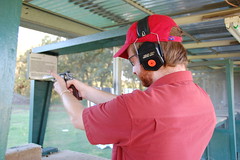 Shortly before I left Texas I had one last swan-song, something that would be quite difficult for me to do in New Zealand. Shoot a gun, many guns in fact. I drove up to the local shooting range in my rental car, opened the shop door and stepped into a foreign world. At first glance, it looked just like a “mom & pop” bait shop: the sort of place you would visit if you were about to go for a little stint of fishing off the New Zealand coast. Except, instead of bait & tackle, there was ammunition, instead of fishing rods, there were semi-automatic rifles. Disembodied animal heads nailed to the walls made up the traditional Texas décor. The door closed behind me and I turned to find (to my great bemusement) a target made up of Osama Bin Laden with a semi-automatic rifle in his hands. I certainly was in Texas.
Shortly before I left Texas I had one last swan-song, something that would be quite difficult for me to do in New Zealand. Shoot a gun, many guns in fact. I drove up to the local shooting range in my rental car, opened the shop door and stepped into a foreign world. At first glance, it looked just like a “mom & pop” bait shop: the sort of place you would visit if you were about to go for a little stint of fishing off the New Zealand coast. Except, instead of bait & tackle, there was ammunition, instead of fishing rods, there were semi-automatic rifles. Disembodied animal heads nailed to the walls made up the traditional Texas décor. The door closed behind me and I turned to find (to my great bemusement) a target made up of Osama Bin Laden with a semi-automatic rifle in his hands. I certainly was in Texas.
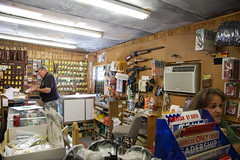 The shooting range operated rather simply: the range was either hot or cold, while hot, people were shooting the living daylights out of their targets, while cold, no one was to touch their guns or the tables the guns were on. Apart from that there was no regulation or license required, just point and shoot and have a good time.
The shooting range operated rather simply: the range was either hot or cold, while hot, people were shooting the living daylights out of their targets, while cold, no one was to touch their guns or the tables the guns were on. Apart from that there was no regulation or license required, just point and shoot and have a good time.
I missed the five minute “how to shoot” instruction since I had to go get cash (cash only for some reason), but the mechanics of a gun is quite simple really.
 For starters, all guns have a very simple structure: a bullet (consisting of a payload, gunpowder and a casing); a chamber (where the bullet goes); a barrel (along which a bullet will travel when struck); a hammer (which hits the backside of the bullet and makes the gunpowder explode); and a trigger (which sets the mechanism off). Operating a gun of any sort involves loading a bullet into the chamber, cocking the hammer back, striking the bullet with the hammer, and removing the empty bullet casing for the next round. The difference in guns really appears to be which bits you do manually and which bits get done for you.
For starters, all guns have a very simple structure: a bullet (consisting of a payload, gunpowder and a casing); a chamber (where the bullet goes); a barrel (along which a bullet will travel when struck); a hammer (which hits the backside of the bullet and makes the gunpowder explode); and a trigger (which sets the mechanism off). Operating a gun of any sort involves loading a bullet into the chamber, cocking the hammer back, striking the bullet with the hammer, and removing the empty bullet casing for the next round. The difference in guns really appears to be which bits you do manually and which bits get done for you.
 In the short time I was there, I played with a 44 calibre Smith & Western, a 22 calibre Ruger and two semi-automatic pistols. The 44 kicked like a mule: you hold it gingerly in your hands and squeeze the trigger, the recoil bucks the revolver back in your hands and you can actually see a fiery brilliant orange muzzle-flare coming out of the front.
In the short time I was there, I played with a 44 calibre Smith & Western, a 22 calibre Ruger and two semi-automatic pistols. The 44 kicked like a mule: you hold it gingerly in your hands and squeeze the trigger, the recoil bucks the revolver back in your hands and you can actually see a fiery brilliant orange muzzle-flare coming out of the front.
The bullet tears a great big impressive hole in your target. The 22 feels like a little pop-gun by comparison: barely moving in your hands, and punching a small hole in the paper.
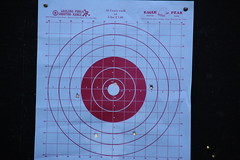 I think these were what are known as double-action revolvers. You put the bullets into their chambers and pull on the trigger, this causes the hammer to cock, turns the chamber to align a bullet with the hammer, and then the hammer drives violently towards the backside of the bullet, igniting the gunpowder and sending the bullet careening down the barrel (hopefully) in the general direction of your target. To make it easier, you can cock the hammer back manually, then all you have to do is lightly tap the trigger, causing the hammer to swing forward and sending your bullet flying. You do have to empty out the cartridges yourself. The 44 removes all 6 at the same time, while the 22 required you remove them one at a time.
I think these were what are known as double-action revolvers. You put the bullets into their chambers and pull on the trigger, this causes the hammer to cock, turns the chamber to align a bullet with the hammer, and then the hammer drives violently towards the backside of the bullet, igniting the gunpowder and sending the bullet careening down the barrel (hopefully) in the general direction of your target. To make it easier, you can cock the hammer back manually, then all you have to do is lightly tap the trigger, causing the hammer to swing forward and sending your bullet flying. You do have to empty out the cartridges yourself. The 44 removes all 6 at the same time, while the 22 required you remove them one at a time.
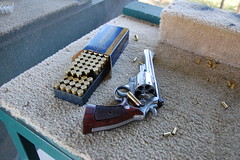 A single-action revolver requires you to cock them manually every time. In other words, the trigger doesn’t pull the hammer back for you. The term “half-cocked” refers to antique rifles which allowed you to half-cock them for the purpose of loading. The idea was that the hammer wasn’t far enough back to ignite the gunpowder and waste your precious shot (which took at best 20 seconds to load). It also meant, however, that you could mistakenly half-cock your gun when you intend to fire, ending up with a gun that doesn’t fire as intended when you pull the trigger. Hence the expression came into being, which refers to someone who, in their haste, makes poor preparation and ends up with unintended results.
A single-action revolver requires you to cock them manually every time. In other words, the trigger doesn’t pull the hammer back for you. The term “half-cocked” refers to antique rifles which allowed you to half-cock them for the purpose of loading. The idea was that the hammer wasn’t far enough back to ignite the gunpowder and waste your precious shot (which took at best 20 seconds to load). It also meant, however, that you could mistakenly half-cock your gun when you intend to fire, ending up with a gun that doesn’t fire as intended when you pull the trigger. Hence the expression came into being, which refers to someone who, in their haste, makes poor preparation and ends up with unintended results.
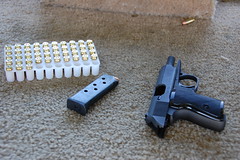 In contrast to the revolvers (so named because the chamber goes around and around, presenting the hammer with a different bullet every time), the semi-automatic pistols have a single chamber for the bullets and use the recoil of one bullet to eject the cartridge, load the next bullet and cock the hammer back all at the same time, quite clever really.
In contrast to the revolvers (so named because the chamber goes around and around, presenting the hammer with a different bullet every time), the semi-automatic pistols have a single chamber for the bullets and use the recoil of one bullet to eject the cartridge, load the next bullet and cock the hammer back all at the same time, quite clever really.
It’s achieved through a number of springs and bits of metal and allows you to load more bullets into your magazine at a time, allowing you to focus more on killing things than the mechanics of your gun.
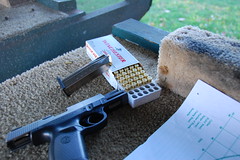 It does mean, however, that you have to cock the first round manually. In practice I found that they kept jamming, with a cartridge half-caught in the chamber and half out, requiring you to pull the hammer back yourself, to eject the spent cartridge.
It does mean, however, that you have to cock the first round manually. In practice I found that they kept jamming, with a cartridge half-caught in the chamber and half out, requiring you to pull the hammer back yourself, to eject the spent cartridge.
Also, if you held the gun wrong, you could mistakenly eject the cartridge, which would be deadly embarrassing in a real gun-fight.
For this reason, I preferred the feel of the revolvers, which had a far more reliable track-record in my hands.